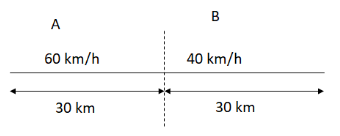Question
Question: A car covers \[30\,{\text{km}}\] at a uniform speed of \[60\,{\text{km}}{{\text{h}}^{ - 1}}\] and th...
A car covers 30km at a uniform speed of 60kmh−1 and the next 30km at a uniform speed of 40kmh−1. Find the total time taken.
A. 30min
B. 45min
C. 75min
D. 120min
Solution
We are asked to find the total time taken by a car to travel the total distance of 60km. As, the speed is different for the first 30km and next 30km, so find the time taken for each part separately and add them to find the total time taken. You will need to use the formula for time taken in terms of distance and speed.
Complete step by step answer:
Given, a car covers a distance 30km at a uniform speed of 60kmh−1.
And covers next 30km at a uniform speed of 40kmh−1.
The formula we will use to calculate the time taken is,
timetaken=SpeedDistance ……………(i)
Let us draw a rough diagram to understand the problem properly.

We have divided the problem into two parts, part A and part B.
In part A, the car covers distance, dA=30km with uniform speed, vA=60kmh−1
In part B, the car covers distance, dB=30km with uniform speed, vB=40kmh−1
Now, we will find the time taken for part A and part B separately and then add them to find the total time taken.For part A, using the formula from equation (i) we get the time taken as,
tA=vAdA
Putting the values of dA and vA, we get,
tA=60kmh - 130km
⇒tA=21hr
⇒tA=0.5hr ………………(ii)
For part B using the formula from equation (i), we get the time taken as,
tB=vBdB
Putting the values of dB and vB, we get
tB=40kmh - 130km
⇒tB=43hr
⇒tB=0.75hr …………………(iii)
Therefore, we will get the total time taken by adding the time taken in part A and time taken in part B.
∴ttotal=tA+tB
Putting the values of tA and tB, we get
ttotal=0.5hr+0.75hr
⇒ttotal=1.25hr
The options are given in minutes, so we convert hours to minutes.
ttotal=1.25×60min
∴ttotal=75min
Therefore, total time taken is 75min.
Hence, the correct answer is option C.
Note: Remember whenever speeds are different for the same distance travelled, the time taken will also be different. If in the given question the speeds for part A and part B were the same, then we could calculate the total time taken using the total distance covered and the speed without calculating for each part separately.
